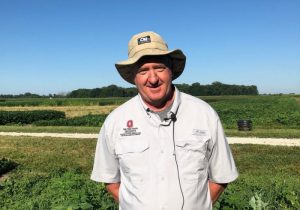Herbicide Programs for non-GMO soybeans
By Dr. Mark Loux, OSU Extension State Weed Specialist. Adapted from C.O.R.N. 2020-39
An updated version of the fact sheet “Herbicide Programs for non-GMO soybeans” is now available. A print ready version is available. It can also be found on Ohioline.  The basic approach with herbicides has not changed much. Weed control in non-GMO soybeans can be challenging, and increases the selection for resistance to site 14 herbicides (fomesafen, Cobra). The new version emphasizes several things, including:
The basic approach with herbicides has not changed much. Weed control in non-GMO soybeans can be challenging, and increases the selection for resistance to site 14 herbicides (fomesafen, Cobra). The new version emphasizes several things, including:
– Plant non-GMO soybeans in fields with a history of several years of crop rotation and effective weed control that has prevented weed seed return to the soil and reduced weed populations.
– Maintain a rotation where non-GMO soybeans are planted every four years, with two years of corn and one year of traited soybeans in between, or other crops as appropriate for the farm operation.
– Fall herbicide treatments should be used to manage marestail, winter annuals, dandelion, and other perennial weeds. Marestail can be especially difficult to control in no-till, non-GMO soybeans unless a fall herbicide treatment is used.
– Planting non-GMO soybeans in fields with waterhemp is not recommended due to the high frequency of resistance to ALS and PPO inhibitors, which eliminates all POST options for control.

Fall Herbicide Treatments
Fall herbicide treatments should be used to manage marestail, winter annuals, dandelion, and other perennial
weeds. Marestail can be especially difficult to control in no-till, non-GMO soybeans unless a fall herbicide treatment
is used. We suggest applying a mixture of 2,4-D with one of the following: glyphosate, dicamba, a low rate of Canopy/
Cloak EX/DF, or another ALS product (Basis, etc.). This should be followed by a spring preplant application of
burndown, plus residual herbicides.
Note on Giant Ragweed
Two POST applications are usually necessary to control giant ragweed unless the population is very low. Apply fomesafen when giant ragweed are 6 to 10 inches tall and follow-up with Cobra/Phoenix three weeks later. OSU research shows that this three-week interval works in all populations. Do not delay the first POST application and do not fail to make the second POST application because it appears that soybeans are close to canopy closure.
Note on Waterhemp
Planting non-GMO soybeans in fields with waterhemp is not recommended due to the high frequency of resistance to ALS and PPO inhibitors, which eliminates all POST options for control. In fields where waterhemp is absent or still sensitive to PPO inhibitors, follow the suggested basic POST program. One of the following herbicides can be included in the POST application to provide residual control of waterhemp for several more weeks – metolachlor, Zidua, Anthem, Outlook, Warrant.
Note on Marestail
There are no POST herbicides that control marestail in nonGMO soybeans. Effective control requires appropriate fall and spring burndown herbicides, and appropriate residual herbicides (see comments above).
As always, contact us with questions or for more information – loux.1@osu.edu.